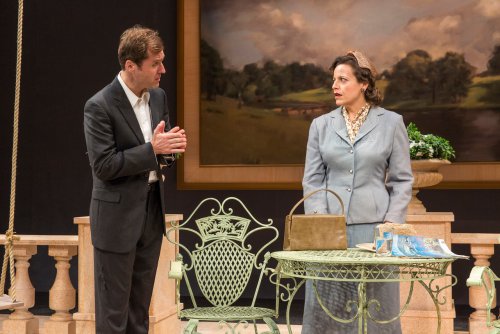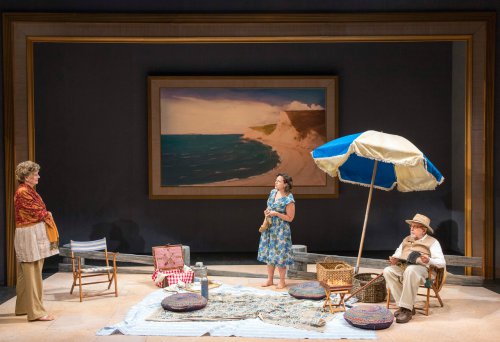A Day by the Sea
Wise and compassionate drawing room drama about lives of regret by British playwright N.C. Hunter gets an impeccable revival by always reliable Mint Theater.

Jill Tanner, Julian Elfer, George Morfogen and Philip Goodwin in a scene from “A Day by the Sea” (Photo credit: Richard Termine)
[avatar user=”Victor Gluck” size=”96″ align=”left” ] Victor Gluck, Editor-in-Chief[/avatar]Forgotten British playwright N.C. Hunter seems to be having an American renaissance, courtesy of the Mint Theater Company which gave the American premiere of his 1951 A Picture of Autumn an exquisite production in 2013. It is now presenting a revival of his 1953 A Day by the Sea, his only play to reach Broadway. In its London incarnation the play featured a stellar cast including Sir John Gielgud, Sir Ralph Richardson, Dame Sybil Thorndyke, Sir Lewis Casson and Irene Worth. In addition, The Mint has recently given a staged reading of his most successful play, Waters of the Moon which originally ran for 835 performances in London with a cast made up of Dame Edith Evans and Dame Sybil, and included Ingrid Bergman and Wendy Hiller in its more recent West End revival. In the 1950’s, Hunter was obviously the darling of British theater aristocracy.
The original Broadway cast of A Day by the Sea included the acting team of Hume Cronyn and Jessica Tandy as well as veteran stage and screen stars Aline McMahon, Dennis King and Halliwell Hobbs. Its quick demise may have been based on the fact that its gentility was out of step with the reigning dramas from Tennessee Williams, Arthur Miller and William Inge. Although a major London crowd pleaser at the beginning of the 1950’s, Hunter’s decline in popularity can be traced to the rise of John Osborne and the Angry Young Men writers. Hunter’s drawing room drama-style was diametrically to their kitchen sink variety of playwriting.
Now that we have been through all the angry play movements, literate writers like N.C. Hunter and Terence Rattigan are once again ripe for revival. While in his own time, Hunter was criticized for being too much like Chekhov that now seems a plus in the days of sloppy craftsmanship and plays that are really movie scenarios staged in the theater. A Picture of Autumn was obviously a post-war British variation on Chekhov’s The Cherry Orchard, while Waters of the Moon resembles The Sea Gull. A Day by the Sea owes a great deal to Chekhov’s Uncle Vanya and includes the same basic cast of characters.

Julian Elfer and Katie Firth in a scene from “A Day by the Sea” (Photo credit: Richard Termine)
Ironically, A Day by the Sea’s post-World War II setting has the same mood as that which led to Brexit in Britain and The Tea Party in the United States: a state of anxiety in which the world seems to be in a very bad way and the problems seem insurmountable and not being addressed by our politicians. Middle-aged Julian Anson, a minor British diplomat who has only risen to the level of First Secretary of the Paris Embassy after a long career in the Foreign Service, has come home to Dorset for a rare visit. His mother Laura, wanting to see him married, has invited Frances Farrar and her two children for a long visit. Frances, widowed from her first husband and divorced from her second, grew up in this house by the sea along with Julian when she was orphaned at age nine. This is her first visit in 20 years. Obviously, she had has a reason for avoiding her childhood home.
However, Julian is not the only one with regrets. His Uncle David, aged 82, sleeps all day and mourns the things he can no longer do. Doctor Farley, his caregiver, secretly drinks to forget his past. Lawyer William Gregson rues his rejection of his late sister due to her feckless husband. Laura deplores Julian’s unmarried state and his choice of career. And Frances wishes she can undo the romantic life she has led that has made her catnip for the tabloids. On the day when Laura has all of her guests go for a picnic by the sea, the workaholic Julian is confronted with the fact that he has been a failure in his career and unpopular with his colleagues. At age 40, is it too late for Julian to make a radical change before it becomes irreversible?
A Day by the Sea’s first act is entirely made up of exposition and back stories, and Austin Pendleton’s leisurely direction makes the play slower than it needs to be. Throughout the cast seems to be too conscious of trying to be British. And then in the second of the play’s three acts all of the characters seem to have a catharsis as to what their lives might be and the temperature heats up. The casting could not be better and the play turns extremely poignant as Hunter’s characters must come face to face with the choices they have made.

Jill Tanner, Katie Firth and George Morfogen in a scene from “A Day by the Sea” (Photo credit: Richard Termine)
Julian Elfer as the unsuccessful middle-rung diplomat has the style of a man who never quite commits himself down pat and we ache for him as he tries to make a drastic change in the play’s third act. Veteran actors Jill Tanner and George Morfogen who also appeared in The Mint’s production of Hunter’s A Picture of Autumn are elegance itself as Julian’s mother and uncle. While Katie Firth (who also appeared in that production) does not show exhibit the flirtatiousness that obtained her two husbands and the allure that makes her so attractive to men, she deftly creates a portrait of a woman approaching middle-age who regrets the choices she has made.
As the alcoholic doctor now caregiver, Philip Goodwin is saddled with a great many rants but he is a believable character as the play’s moral center. Polly McKie is heart-breaking as Frances’ dowdy and plain governess who is about to be out of a job and has developed a crush on the doctor who is two decades older. Curzon Dobell and Sean Gormley give able support as the unhappy lawyer and a British diplomat of rank, respectively. Together the cast makes a true ensemble of British lives as they were lived in 1951.
Charles Morgan’s stylish and stylized setting makes a statement of its own. Both Mrs. Anson’s terrace and the nearby beach are seen in a receding gold archway with two different gold framed paintings on the back wall which gives the play a 19th century feel. Morgan seems to be saying that these people are stuck in a lifestyle that has seen its day. The costumes by Martha Hally are redolent of the play’s early 1950’s time frame. Xavier Pierce bathes the play in a kind of golden glow that suggests this world’s last hurrah. The lovely violin and piano music is by Jane Shaw. Robert-Charles Valence is responsible for the wig and hair design of the period.
N.C. Hunter’s A Day by the Sea may not be as charming as his more accessible A Picture of Autumn but it is a wise and compassionate view of a specific world with a message that may be very timely. The excellent performances by Austin Pendleton’s top-drawer cast make this a particularly fine evening. A Day by the Sea gives up its riches only gradually in its well-crafted form of playwriting, but the ultimate rewards are great.
A Day by the Sea (extended through October 30, 2016)
Mint Theater Company
The Beckett Theatre on Theatre Row, 410 W. 42nd Street, in Manhattan
For tickets, call 212-239-6200 or visit http://www.Telecharge.com
Running time: two hours and 35 minutes including two intermissions






Leave a comment